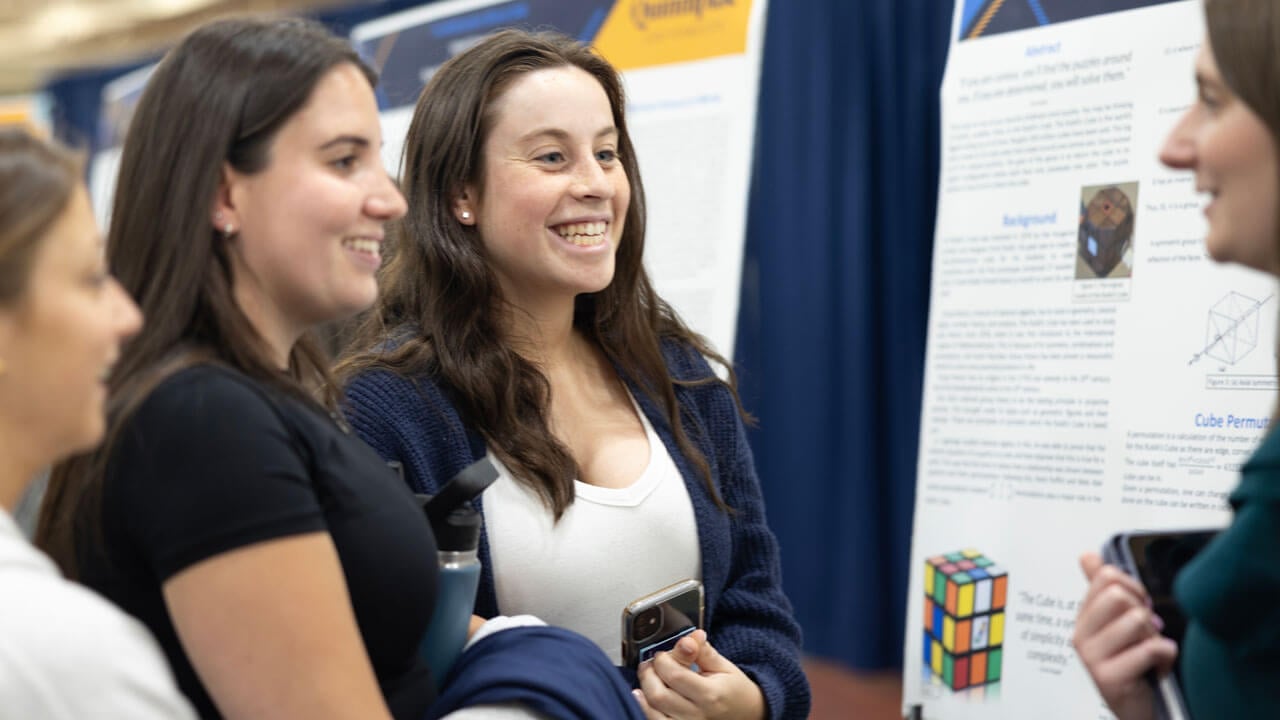
Basso, who will graduate with her Bachelor of Arts this weekend, sees six sides — and 43 quintillion permutations — every time she picks up a Rubik’s Cube and thinks about all the different combinations.
A twist here. A twist there. You get the idea.
The iconic toy, the invention of Hungarian professor Ernö Rubik, is also a powerful teaching tool. “Rubik built it for his students so they could look at a 3D monolith,” Basso said. “It has great problem-solving applications for high school students. It makes math less scary.”
Basso was one of well over 100 students Friday who shared their poster presentations, research projects and video games at the 2024 College of Arts and Sciences Student Research Symposium at the Recreation and Wellness Center.
The showcase event, which featured students in the final year of their programs, marked the first school-wide projects day for the College of Arts and Sciences.
“It’s fun and it’s inspiring. I'm so proud of our students. And I think they’re proud, too,” said Deborah Clark, professor of biology, chair of biological sciences and one of the organizers of the symposium. Other organizers included Jen Sacco, professor of political science and women's & gender studies, chair of philosophy and political science; and Rick DelVecchio, director of career development at CAS.
“There's something very special about printing your work on big poster boards and showing everyone what you learned,” Clark said, adding that Dean Adam Roth’s support was instant and unconditional. “It’s the perfect time to have something like this. I’ve actually made a point to go around and talk to students from other disciplines. They’re all so impressive.”
Finding a cure for Huntington’s disease
Olivia Dempson ’23, MS '24, a 4+1 student finishing her Master of Science in molecular and cell biology, presented her key research on Huntington’s disease and its neurodegenerative causes. Last month, Dempson presented at the prestigious Allied Genetics Conference in Washington, D.C. Her work focuses specifically on the role of microRNA-71.
“There are no therapeutic mechanisms right now to treat Huntington’s. It severely affects your neurons, and it comes about so quickly,” Dempson said. “You’re diagnosed and you have to live with it. Hopefully, research like this will open the future to therapeutic targets. ... Once your neurons degenerate, there’s really no process to repair them.”
Dempson has worked closely with Alexandre de Lencastre, a professor of biology and the director of the graduate program in molecular and cell biology. His lab studies the role of microRNAs and how they can affect neurodegenerative diseases such as Huntington’s, Alzheimer’s and Parkinson’s.
“Olivia is really skilled. She brings a lot of organization and energy to this project. She’s gotten some great results. She’s a star, for sure,” de Lencastre said. “Olivia became very independent this year. I would mentor her, but she was able to do her own research and that’s important.
"I’m there to mentor students, but I want them to ask their own questions, troubleshoot their own problems, do their own critical thinking and analyze their data in consultation with me,” he added. “That gives students real skills that they can apply to the workforce. That’s what you want your students to come away with.”
Game designers will remember ‘Forgetism’
Madi Smith ’24, a game design and development major, created “Forgetism” with her QU classmates Anthony Thompson ’24, Spencer Hanlon ’24 and Toma Brown ’24. Together, the group made “a puzzle game where the character you play as is a gumball machine scientist who has to smack himself in the head to forget different movement directions to pass the levels.”
Smith and Hanlon wrote code for the game’s mechanics and movement, while Brown was in charge of the art and Thompson was responsible for the music. Collectively, their work was overseen by Christopher Blake, of game design and development.
The group began work on the game in October, but never lost its sense of humor. “The whole premise of a gumball machine scientist losing his marbles was what really drew people to see what our game was about,” Smith said.
Along the way, the group presented “Forgetism” at PAX East, a huge gaming convention in Boston. “This year has been a whirlwind because a lot of game development is us making games as teams, but this year, it’s been taking everything we’ve learned and everything we’ve done the last four years and just amplifying it.
“It’s challenging because a lot of what I do is in code and that can be so frustrating. I’ll use the game’s portal, for example. It just didn’t want to work, no matter what I did,” Smith said. “But then, when you finally get it to work — and you perfectly fine tune it — that’s the best feeling. It’s so, so rewarding.”
Peeling back the past of HIV and AIDS
Shannon Daniel ’24, who will earn her Bachelor of Arts in political science on Sunday, devoted her research to “Resilience and Resistance: Intersectional Experiences Faced During the HIV Epidemic.” Her work reflects the Reagan administration’s policies toward HIV and AIDS during the 1980s and the impact on affected communities.
“My project focuses on the Black LGBTQ community as well as the entire collective of gay people during that time,” Daniel said. “Everyone was under scrutiny, but Black people in particular didn’t have the representation, the resources and the government on their side.
“The Reagan administration tried to conceal AIDS and HIV and limit it to gay people. Many AIDS initiatives were cut by the CDC or never even considered. It was called a ‘gay disease’ because that’s how the government framed it,” Daniel said of her quantitative analysis of the administration’s policies.
Daniel also explored the reach of AIDS and HIV through a more expressive lens. She credits Candice Travis, visiting assistant professor of political science, for helping her shed light on the darkness of that era.
“I also looked at the intersectionality of it through a qualitative analysis — intravenous drug users, women, hemophiliacs, bisexual men and Black LGBTQ individuals,” Daniel said. “It wasn’t just one group that was affected by the Reagan administration. It was many more.”
The math doesn’t lie, even if the number is 43 quintillion — a 43 followed by 18 zeroes.
Just ask Ernö Rubik.
Basso quoted him prominently on her poster: “If you are curious, you’ll find the puzzles around you. If you are determined, you will solve them.”
In this Article
Stay in the Loop
Quinnipiac Today is your source for what's happening throughout #BobcatNation. Sign up for our weekly email newsletter to be among the first to know about news, events and members of our Bobcat family who are making a positive difference in our world.
Sign Up Now




























